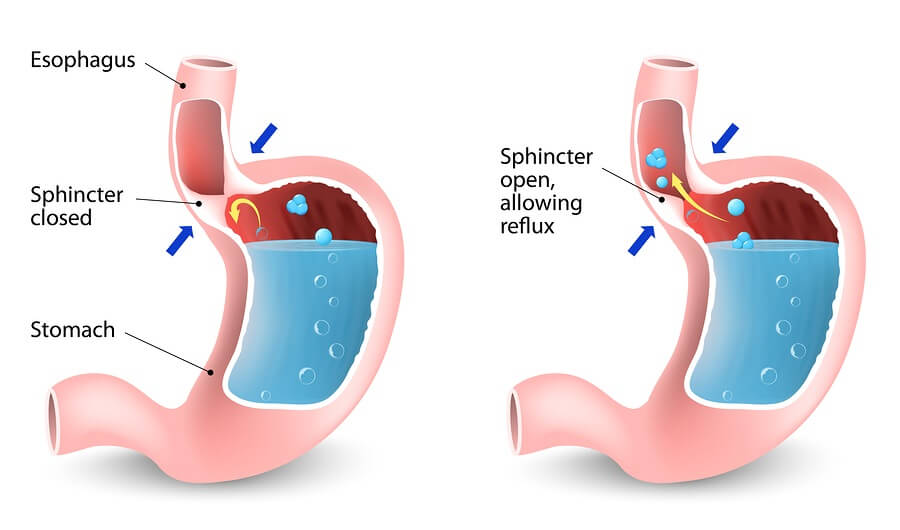Acid reflux is a condition that plagues many people, causing them pain and discomfort. It may or may not be serious. It is then important to know what acid reflux is.
What is acid reflux?
Acid reflux means that your stomach acid is flowing backward into your esophagus.
Normally the valve between your esophagus and your stomach, the esophageal sphincter, prevents this from happening.
When you have acid reflux, there is a malfunction in this valve. This can be caused by overeating and putting too much pressure on the esophageal sphincter.
Another reason is a weakening of the esophageal sphincter muscle. This causes the valve to no longer close tightly.
The biological effect of acid reflux is very similar to what happens to bulimics when they regurgitate their food. The difference is that it is unintentional for acid reflux sufferers.
The acidic pH of the fluid moving up into your esophagus depends on the amount of acid in the regurgitated food. It is also dependent on the pH of your stomach acid.
This can be the difference between mild and severe heartburns.

Pepsin is the primary digestive enzyme in the stomach that breaks down proteins. This enzyme may become embedded in the throat when you have acid reflux.
When this embedded pepsin combines with acids in your food, it can cause significant damage to your tissues.
Sometimes, it leads to severe inflammation. This makes swallowing very difficult and painful.
GERD (Gastroesophageal reflux disease) and acid reflux are not the same. GERD is a chronic and more severe form of acid reflux. It can cause swelling in the esophagus.
What are the symptoms of acid reflux?

The most common symptom is a warm and/or burning sensation in the chest. This sensation may extend into the throat. It is this tell-tale symptom that most people refer to as heartburn.
Some symptoms of acid reflux are not as obvious as a burning sensation.
You may be experiencing a “silent form” of acid reflux if you have these symptoms:
- sour or bitter taste in your mouth,
- sore throat,
- hoarseness,
- chronic cough,
- pressure in your chest,
- asthma-like breathing,
- constantly having to clear your throat.
These symptoms are referred to as “silent” because you don't experience the burning sensation. Therefore, you may not attribute them to heartburn.
“Silent” symptoms of acid reflux can actually be more serious.
You may not even know about the damage to your esophagus and throat until it becomes severe. If you discover that the symptoms described above coincide with your eating, you may take preventative measures. You could try natural remedies too.
If you experience a burning sensation, consult with your doctor. In addition, you may consider natural holistic approaches to treat your condition.
What foods should you avoid?
Canned drinks are highly acidic. Carbonated drinks like soda very often trigger acid reflux.
The Food and Drug Administration (FDA) requires a pH of 4.6 or lower in all canned drinks. This high acidity has two objectives. It retards bacterial growth and prolongs shelf life of the drinks.
Unfortunately, it also causes heartburn. And in some cases it makes the symptoms more severe.
Fruit juices, coffee, tea, and chocolate are also very acidic.
You should at least curtail them if you are prone to heartburn. In fact, you may need to wean yourself of these items completely or only indulge occasionally.
Alcohol relaxes the esophageal sphincter. It can then exacerbate an acid reflux condition.
Alcoholic cocktails that contain fruit juice, soda, or tomato juice can be a double whammy!
Many people experience heartburn after eating fried and/or spicy foods. Onion and garlic are also common culprits.
Keep a food diary
Everyone's system is different. Different foods trigger to varying degrees acid reflux in different people.
For some people, it only takes a single bite of a certain food to cause a bad bout of heartburn.
For other people, it may take much more of that same food to trigger acid reflux.
Sweet peppers and spices are two good examples of these type foods.
A food diary can help you figure out which foods trigger acid reflux. And you will know which foods improve your condition.

The other foods you eat with your trigger foods can also affect whether or not you experience acid reflux.
For example, strawberries or blueberries may trigger acid reflux in those prone to this ailment.
However, if those same people eat their berries blended into a smoothie with milk and bananas, they may not experience any symptoms.
Likewise, some people may be able to tolerate a moderate amount of curry if the curry is combined with coconut milk. However, it could be otherwise if there is no coconut milk.
A food diary can help you figure out what combinations of foods are best.
Some foods can be medicinal for heartburn.
But in some people, they actually trigger acid reflux. Fresh ginger is a great example of this. For thousands of years, ginger has been used to cure a variety of gastrointestinal issues, including acid reflux.
On the other hand, ginger can actually trigger acid reflux in some people!
Some herbal teas, such as peppermint tea and chamomile tea, will lessen heartburn symptoms in most people. But actually, they may trigger these symptoms in a significant minority of people.
Again, a food diary is the best way to determine how a particular food will affect your specific system.
Be sure to record in your food diary all drinks and snacks you have with your regular meals.
Be sure to include a description of how much you consume of a particular food or drink. Take note of any “unusual” ingredients these foods may contain.
When you experience acid reflux symptoms, refer back to your food diary. By examining your diary, you will find exactly what triggered the response.
You can then determine exactly what foods you need to avoid. You can also find what food(s) you need to combine with your trigger foods to avoid heartburn.








